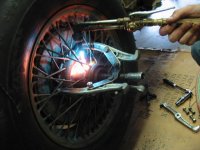Hi all,
At the end of summer I put two new wire wheels on two new hubs on the rear of my BT7. My local garage (who have worked on the car for 20 years) rebuilt the two new front hubs (a bit beyond my skills) and fitted two off the old wire wheels (one was a unworn spare and the other showed no obvious signs of wear). When I picked the car up the mechanic said it had been hard work getting the the wheels onto the hubs (which didn’t sound too good to me). I am not too sure whether they used the spinners to push the wheels on or something else. The garage used "copperslip" on the hubs.
Now I can’t get the front wire wheels off the front hubs. The spinners weren’t on particularly tight when I got the car home, but I couldn’t pull the wheels off. I have tried hitting the tyre from behind while gently spinning the wheel. No movement. I then put the spinners on loosely and tried driving round the garden in a circle and still they would not loose their grip. I’ve thought about borrowing a puller but not sure how to get the arms through the spokes.
Has anyone got any advice to get the wheels off?
I’ve spoken to the garage and they are thinking if there is a different approach.
Phil
At the end of summer I put two new wire wheels on two new hubs on the rear of my BT7. My local garage (who have worked on the car for 20 years) rebuilt the two new front hubs (a bit beyond my skills) and fitted two off the old wire wheels (one was a unworn spare and the other showed no obvious signs of wear). When I picked the car up the mechanic said it had been hard work getting the the wheels onto the hubs (which didn’t sound too good to me). I am not too sure whether they used the spinners to push the wheels on or something else. The garage used "copperslip" on the hubs.
Now I can’t get the front wire wheels off the front hubs. The spinners weren’t on particularly tight when I got the car home, but I couldn’t pull the wheels off. I have tried hitting the tyre from behind while gently spinning the wheel. No movement. I then put the spinners on loosely and tried driving round the garden in a circle and still they would not loose their grip. I’ve thought about borrowing a puller but not sure how to get the arms through the spokes.
Has anyone got any advice to get the wheels off?
I’ve spoken to the garage and they are thinking if there is a different approach.
Phil

 Hi Guest!
Hi Guest!

 smilie in place of the real @
smilie in place of the real @
 Pretty Please - add it to our Events forum(s) and add to the calendar! >>
Pretty Please - add it to our Events forum(s) and add to the calendar! >> 


